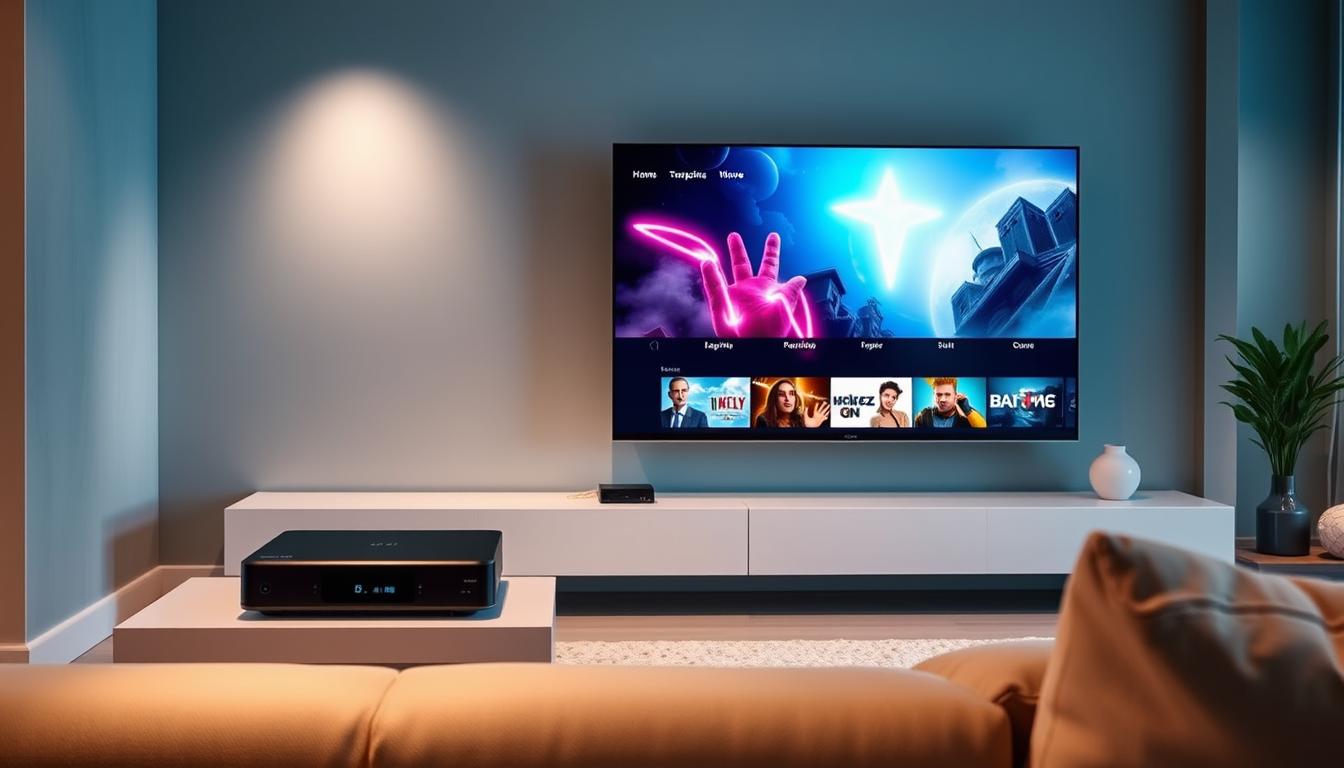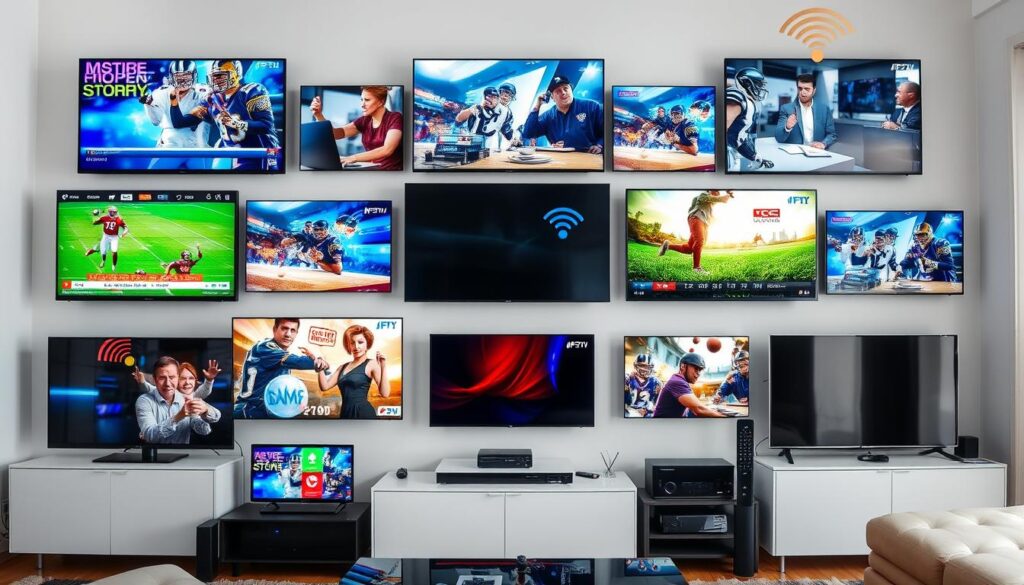
How IPTV Works
In today’s world, watching TV has changed a lot. We no longer need big cable boxes or only a few channels. IPTV, a new tech, is changing how we watch TV. But, you might wonder, how does IPTV work, and what makes it different from old TV?
Key Takeaways
- IPTV, or Internet Protocol Television, uses the TCP/IP suite to send TV shows and videos. It’s not like broadcast, cable, or satellite TV.
- IPTV comes from service providers over special IP networks. It offers both live TV and videos you can watch anytime.
- IPTV gives better control over video quality, uptime, and more. This is better than using the public internet.
- IPTV is easy to use and flexible. It’s why many people choose it for their entertainment needs.
- IPTV has changed how we watch TV. It makes watching TV more dynamic and fun.
Understanding IPTV: What Sets It Apart from Traditional TV
Internet Protocol Television (IPTV) is changing how we watch TV. It’s different from traditional TV, which uses old and new signals through cables or satellites. IPTV uses the internet, making it more flexible and open.
Definition and Basic Concepts
IPTV lets you watch TV shows, movies, and more online. It’s a new way to watch, making it easy to find and watch what you like when you want.
Key Features of IPTV Technology
- Interactivity: IPTV lets you talk back to providers, making watching TV more fun.
- Accessibility: You can watch IPTV on many devices, like smart TVs and phones. This means you can watch anywhere, anytime.
- Personalization: IPTV gives you shows you’ll like and lets you control what you watch. It’s all about what you want to see.
The Evolution from Cable to Internet Protocol
Switching from cable TV to IPTV is a big change. IPTV uses the internet to bring TV to your devices. This change meets the needs of today’s viewers, offering more than traditional TV.
“The global IPTV market is projected to grow at a CAGR of 15.1% between 2023 and 2032, underscoring the rapid adoption of this transformative technology.”
The Evolution of Television Broadcasting
Television broadcasting has changed a lot since 1927. It moved from using antennas to digital TV through cable, satellite, and the internet.
In the early days, TV had few channels and poor quality. But, the 1950s brought color TV, changing how we watch. The late 1970s saw a big change to digital TV with satellite and cable.
The 1980s brought the internet, starting TV online. This led to IPTV, which faced early challenges. But, better internet and streaming made IPTV popular, offering lots of content and features.
Now, cable TV and satellite TV keep changing. Streaming services and fast internet have given us more choices and control over TV.
Television’s history shows amazing progress and innovation. From simple broadcasts to today’s IPTV, TV’s evolution is fascinating.
How IPTV Works
IPTV, or Internet Protocol Television, is changing how we watch TV. It uses the internet to send shows directly to our devices. This method brings better viewing, more flexibility, and personal choices.
Network Architecture and Data Transmission
IPTV sends video over IP networks. Providers use these networks to send content to our devices. They pack the content into packets, compress it, and send it over the internet.
Video Streaming Protocols
IPTV uses many protocols for smooth streaming. These include RTSP for control, HTTP for on-demand, RTP for real-time, UDP for live, and IGMP for multicast. These help ensure content gets to us without delay.
Content Delivery Methods
IPTV offers different ways to get content. For on-demand, it uses one-to-one streaming. For live TV, it uses one-to-many multicast. It works with set-top boxes, smart TVs, and more, giving us more ways to watch.
| IPTV Technology | Video Streaming Protocols | Content Delivery Network |
|---|---|---|
| Leverages managed IP networks | RTSP, HTTP, RTP, UDP, IGMP | Unicast, Multicast |
| Delivers content from provider servers | Enables streaming control, on-demand, real-time delivery, live TV | One-to-one, one-to-many streaming |
| Compatible with set-top boxes, smart TVs, and mobile devices | Ensures seamless content transmission | Optimizes bandwidth utilization |
IPTV uses IP networks and advanced protocols for a better TV experience. It’s changing TV for the better, making it more dynamic and engaging.
Types of IPTV Services Available in Canada
In Canada, IPTV services are getting more popular. They offer a wide range of content and flexible viewing options. The main types are Live TV streaming, Video on Demand (VOD), and Catch-up TV.
Live TV streaming lets Canadians watch programs as they happen. It’s great for news, weather, sports, and live shows. VOD lets users watch pre-recorded content whenever they want. This gives them more control over what they watch.
Catch-up TV lets viewers watch shows they missed for a short time. This way, they can catch up on their favorite shows.
Some top IPTV services in Canada include CBS Sports HQ, Hulu + Live TV, and Sling TV for live TV. Tubi and Pluto TV are good for VOD. BBC iPlayer is great for catch-up TV.
IPTV is becoming more popular in Canada because it’s affordable. It also meets different viewer needs. IPTV providers must follow legal rules and have the right to show content.
For 2024, some top IPTV providers in Canada are BunnyStream, Trendyscreen, TiVistation, IPTVtune, and IPTV THE FOX. They offer many live TV channels, video-on-demand titles, and different subscription plans.
Essential Components of IPTV Systems
To get a full IPTV experience, a strong system is key. IPTV hardware, streaming software, and a solid network work together. They bring your favorite shows right to you.
Hardware Requirements
At the center of IPTV systems are the devices that play content. This includes set-top boxes, smart TVs, or streaming devices. These must handle high-quality video streams for a great viewing experience.
Software and Applications
The software in IPTV systems is just as vital. It includes apps, interfaces, and content systems. These help users find and enjoy content easily, making their experience better.
Network Infrastructure
Fast and reliable internet is the heart of IPTV. A strong network, with broadband, routers, and servers, is needed. It ensures smooth video streaming without breaks. The system can be central or spread out for better performance.
With IPTV hardware, software, and a solid network, users get a top-notch digital TV experience. It’s more than just cable or satellite TV.
IPTV Streaming Quality and Bandwidth Requirements
IPTV’s video quality and bandwidth are key. It uses the internet to stream content. The network’s performance greatly affects your viewing.
Video quality in IPTV varies by content type. SD TV channels need 2-5 Mbps bandwidth. HD channels require 4-10 Mbps. For 4K, you need 25 Mbps or more.
IPTV uses adaptive bitrate streaming. It adjusts video quality based on bandwidth. This ensures smooth streaming without interruptions.
| Content Type | Typical Bandwidth Requirement |
|---|---|
| Standard Definition (SD) | 2-5 Mbps |
| High Definition (HD) | 4-10 Mbps |
| 4K Streaming | 25 Mbps or more |
Network stability is vital for good streaming. IPTV providers use traffic shaping and bandwidth limiting. This helps during busy times.
Knowing bandwidth needs and network importance helps. This way, you can choose the right IPTV subscription. And make sure your internet supports it.
Security and Content Protection in IPTV
IPTV is getting more popular, and keeping content safe is key. IPTV uses many ways to protect copyrighted stuff and stop unauthorized access. These steps help keep IPTV services safe and follow content rules.
Digital Rights Management (DRM)
Digital Rights Management (DRM) is a big part of IPTV security. It makes sure only allowed users can see and use the content. DRM encrypts the content and controls who gets the keys to unlock it.
Encryption Methods
IPTV content is sent securely with encryption. This method scrambles the digital signals, so only those with the right keys can see it. It keeps the content safe from people who shouldn’t see it.
Access Control Systems
IPTV uses access control systems for user checks. These systems make sure only real subscribers can use the service. They use login details and extra security like two-factor auth.
These security steps help IPTV providers keep their content safe. They protect their rights and offer a reliable service to users. As IPTV grows, keeping content safe will become even more important.
“IPTV security is not just about protecting content, but also about building trust and confidence in the IPTV ecosystem.”
Benefits and Limitations of IPTV Technology
IPTV has changed how we watch TV. It lets us watch lots of shows anytime we want. We can also watch on different devices without trouble.
It’s great because it doesn’t have ads like old TV. This makes watching TV much better.
But, it needs a good internet connection. If the internet is slow, watching TV can be bad. Some people find it hard to use at first.
Still, more and more people are using IPTV. They like how easy it is to use. This shows that the good things about IPTV are worth it.
As the IPTV industry grows, I’m looking forward to new improvements. I hope it will get even better for all of us.
FAQ
What is IPTV and how does it differ from traditional TV?
IPTV uses the internet to send TV shows and videos. It’s different from old TV, cable, or satellite. It lets you watch live TV and videos anytime you want.
What are the key features and benefits of IPTV technology?
IPTV lets you watch what you want, when you want. It also talks back to you, making TV more interactive. It’s like old TV but better because you can watch it anytime.
How has the evolution of television broadcasting led to the development of IPTV?
TV started with old signals and moved to digital. The internet came along and TV went online. This led to IPTV in the 1990s.
What are the key components and infrastructure required for IPTV systems?
You need special boxes, smart TVs, or devices to watch IPTV. There’s also software and a strong internet connection. This includes routers and servers for smooth video.
What are the different types of IPTV services available in Canada?
In Canada, you can get Live TV, Video on Demand, and Catch-up TV. Services like CBS Sports HQ and Hulu + Live TV are popular.
How does IPTV streaming quality and bandwidth requirements differ from traditional TV?
IPTV quality depends on your internet speed. HD needs more speed than SD. Providers adjust quality based on your internet, making it better or worse.
What security measures are in place to protect IPTV content and prevent unauthorized access?
IPTV uses special security like DRM and encryption. This keeps your content safe and follows rules for streaming.
What are the main benefits and limitations of IPTV technology?
IPTV is great because you can watch what you want, anytime. It works on many devices and is interactive. But, it needs good internet, can buffer, and is complex for some.


